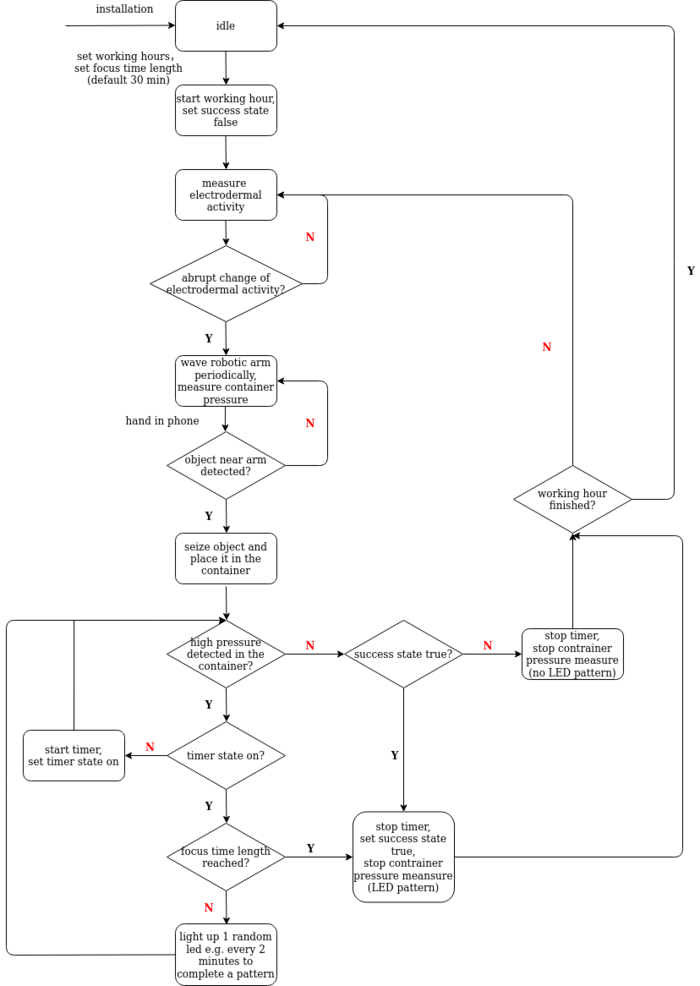My wiki:JW, YS
System Description[edit]
“Digital stress cleaner” is a system that is designed for disengagement of digital consumption. Due to the “attention economy”, digital products like “Tik Tok”, “Instagram” are designed to make users addicted to it and therefore users did not do productive work, which causes anxiety.
During study hours, this system will monitor user’s anxiety by using EDA (electrodermal activity). If the EDA shows the user is under stress, the system will give the user a signal which is sent by robotic arm(swing back and forth) This signal is a kindly reminder that the user is playing with the smartphone for too long and should hand in the smartphone to the designated area. The robotic arm which is mounted on the table, will then detect the smartphone by using IR distance sensor. If the user has put it to the designated area, the robotic arm will clamp it and put it into the container which will detect if the smartphone is within it by using pressure sensor. Then comes the gamification part: the LED matrix display will begin to draw one random point every two minutes. After the user has successfully concentrated on his/her work for a long time, the whole pattern will be shown, which will be different every time.
Annotation:
- The user’s mental state is normal by default. We assume stress is caused by compulsory checking of smartphone/ unstoppable consuming short videos, procrastination and so on.
- Users can set up when the study hour is. Before study hours begins, the user will turn on the robot arm, put on EDA devices and other preparation.
- This system does not require users to hand in their phones at the beginning or do not allow users to touch their phones like other time management applications, because users may need their phones when they encounter problems. It works like a monitor and only takes action when necessary.
- The container is equipped beside the table where it is not that easy reachable for users. But it is not far away for robotic arm.
- The gamification part is a reward. It works like other applications where trees can be planted. It is also an embodiment of the refreshed mental state.
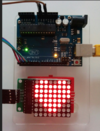
System Architecture[edit]
- Desired goals: A disengaging system design that promotes users working efficiently and maximizing their own well-being
- Methods: monitor and reduce inappropriate cell phones use in order to manage stress and anxiety of the user
- [arrived] EDA: https://www.reichelt.de/arduino-grove-gsr-sensor-grv-gsr-sens-p191210.html?&trstct=pos_0&nbc=1
- [arrived]Metal Robot-Arm Kit
https://www.reichelt.de/metall-roboter-arm-kit-fuer-raspberry-pi-4-dof-rpi-robot-arm-p266037.html?CCOUNTRY=445&LANGUAGE=de&trstct=pos_0&nbc=1&&r=1 - [arrived] IR Distance sensor
https://www.reichelt.de/infrarot-abstandssensor-gp2y0a21yk0f-rbt-sen-ir01-p258659.html?&trstct=pos_2&nbc=1 - [arrived] Ultra sound distance sensor
https://www.reichelt.de/entwicklerboards-ultraschall-abstandssensor-hc-sr04-debo-sen-ultra-p161487.html?&nbc=1&trstct=lsbght_sldr::284398 - [arrived] Pressure sensor
https://www.reichelt.de/de/de/arduino-drucksensor-20-g-bis-10-kg-ard-sen-pressure-p284398.html?trstct=pos_0&nbc=1&&r=1 - [arrived] Led matrix
https://www.conrad.de/de/p/wemos-8x8-matrix-led-shield-v1-0-0-fuer-d1-802231563.html#productDescription - Task:
- Load cell connected to pi
- LED matrix connected to esp32
- Pi web server interface
- Eda connect to pi and read data
- Pir sensor connect to pi and detect movement
- Minimum: load cell, led, eda, pir.
- Nice to haves: web server interface: 1. showing live data from all elements, 2. Using buttons to control the start time of the system.
- Task: Robot arm building and control, Communication between all elements
- Risk:
- Arm can not hold the object at the proper time (slow reaction)
- Arm can not put the object into the proper place (movement direction control)
- Arm can not move flexibly (4 axis mechanical design)
- Coordination between elements
- Minimum: Movable arm, able to hold object All elements work well separately
- Task: Video, Teaser, 4 pages system description (including code, photos, schematics, etc.), Presentation preparation
- User test / survey
- Is user’s stress reduced?
- Electrodermal activity comparison
- Screen time report
- ...
- https://theweek.com/articles/688639/5-sciencebacked-ways-break-phone-addiction
- https://en.wikipedia.org/wiki/Problematic_smartphone_use
- https://howtomechatronics.com/tutorials/arduino/diy-arduino-robot-arm-with-smartphone-control
- https://iml.dfki.de/cognitive-load-measurement-using-electrodermal-activity/
- https://www.waveshare.com/wiki/Robot_Arm_for_Pi
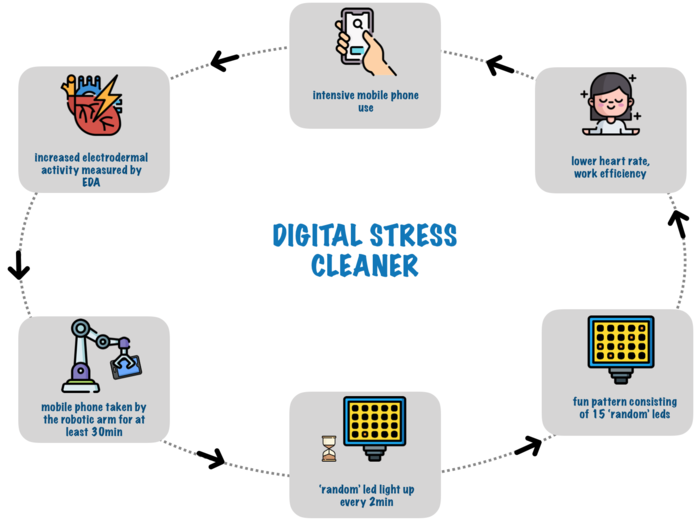
Workflow:
Core Components:
| Technology/materials | Purpose |
|---|---|
EDA (electrodermal activity)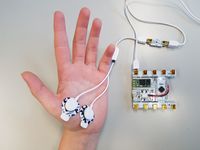 |
Measure electrodermal activity |
Robotic arm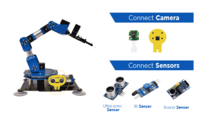 |
Actively take away cellphones and detect cellphones with IR distance sensor |
Pi zero/Pi3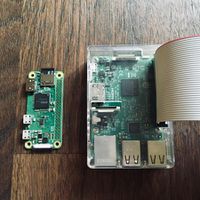 |
Data center |
P3 touchscreen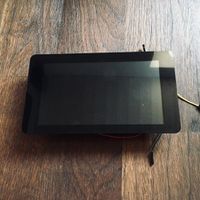 |
Dashboard, display sensor data and other relevant information (nice to have) |
LED matrix |
Visualize time duration |
Required Hardware[edit]
Relation to Digital Health[edit]
“Instead of improving our lives, technology is increasingly getting in the way of enjoying our lives. And the biggest source of trouble is that device that's with you wherever you go.” We can confidently but not really proudly admit that we, people who are stuck in the modern society, have a problem with digital devices, especially with the cellphones. This problem is known as smartphone addiction, smartphone overuse or cellphone dependency. The problematic use of cellphones comprehends “preoccupation with mobile communication, excessive money or time spent on mobile phones, and use of mobile phones in socially or physically inappropriate situations”. Pardon the bluntness, but we are mostly, if not all, phone junkies.
While being a phone junkie at home harms none, being one at work may cost quite a bit. Facing this issue, our ultimate vision is to “rescue” people from their addiction at the workplace. “Digital Stress Cleaner” (DSC) is the first baby step towards this goal. DSC helps users get used to a low proximity to their cellphones. Daily enforcement along with the small treat (gradually formed LED pattern) will eventually replace users’ old unhealthy habit of cellphone overuse with a new one, which is associated with an intrinsic disengagement of cellphones, higher working efficiency and a better, calmer mental state.
Milestones[edit]
1st Milestone: - 22.01 (Done)
2nd Milestone: 22.01- 01.03
3nd Milestone: 01.03 - 12.03
Implementation[edit]
WS2812B LED MATRIX
Sn74ahct125n pinout
protection circuit https://www.led-studien.de/schutzschaltung-fuer-ws2812-pixel/
Tutorial https://docs.micropython.org/en/latest/esp8266/tutorial/neopixel.html
https://randomnerdtutorials.com/micropython-ws2812b-addressable-rgb-leds-neopixel-esp32-esp8266/
Rgb color chart https://www.rapidtables.com/web/color/RGB_Color.html
Interesting to check https://gpiocc.github.io/learn/micropython/esp/2020/05/30/martin-ku-control-neopixels-over-the-internet-with-esp32-and-micropython.html
Load cell https://github.com/dcrystalj/hx711py3 https://www.instructables.com/Arduino-Scale-With-5kg-Load-Cell-and-HX711-Amplifi/
Robotic arm https://www.waveshare.com/wiki/Robot_Arm_for_Pi
Web Server https://randomnerdtutorials.com/raspberry-pi-web-server-using-flask-to-control-gpios/
GSR sensor: galvanic skin response https://wiki.seeedstudio.com/Grove-GSR_Sensor/
Hard and software configuration: https://wiki.seeedstudio.com/Grove_Base_Hat_for_Raspberry_Pi/ Grove Base Hat for Raspberry Pi
